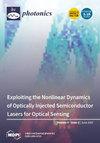不同年龄组主观屈光度数的重复性
IF 2.1
4区 物理与天体物理
Q2 OPTICS
引用次数: 0
摘要
背景:本研究的目的是评估不同年龄组的主观屈光度数在检查者之间的可重复性,这是以前从未研究过的方面。研究方法:这项横断面随机研究共招募了 86 名参与者(平均年龄:37.0 ± 18.0 岁),分为三组:青少年组、非老花眼成人组和老花眼成人组。每位参与者分别在不同的日期接受了由三位不同验光师进行的三次主观屈光检查。重复性分析包括所有屈光变量(M、J0 和 J45)。结果:无论是总体样本还是不同年龄组,验光师之间在所有屈光变量上都没有明显差异(p ≥ 0.05)。此外,参与者的年龄与不同验光师之间屈光变量的平均差异之间也没有相关性(p ≥ 0.05)。总样本的重复性 (r) 的 95% 置信区间为:M 为 ±0.70 D,J0 为 ±0.29,J45 为 ±0.21 D。结论:根据这些发现和以往的研究,建议在验证新的屈光系统时,将主观屈光度数作为金标准,无论被评估者的年龄如何,M 的 95% 置信区间为 ±0.75 D,J0 和 J45 的 95% 置信区间为 ±0.25 D 至 ±0.50 D。本文章由计算机程序翻译,如有差异,请以英文原文为准。
Repeatability of Subjective Refraction in Different Age Groups
Background: The purpose of this study was to assess the inter-examiner repeatability of subjective refraction across diverse age cohorts, an aspect not previously investigated. Methods: A cross-sectional, randomized study enrolled 86 participants (mean age: 37.0 ± 18.0 years), distributed into three groups: youth, non-presbyopic adults, and presbyopic adults. Each participant underwent three subjective refractions by three different optometrists on separate days. Repeatability analysis encompassed all refractive variables (M, J0, and J45). Results: There were no significant differences between optometrists in all refractive variables for either the overall sample or across age groups (p ≥ 0.05). Additionally, no correlation was found between participants’ age and the mean difference in refractive variables across optometrists (p ≥ 0.05). The 95% confidence interval of repeatability (r) for the total sample was ±0.70 D for M, ±0.29 for J0, and ±0.21 D for J45. Conclusions: Based on these findings and previous research, it is suggested to establish 95% limits of agreement of ±0.75 D for M, and between ±0.25 D and ±0.50 D for both J0 and J45 when validating new refraction systems compared to subjective refraction as the gold standard, regardless of the age of the subjects evaluated.
求助全文
通过发布文献求助,成功后即可免费获取论文全文。
去求助
来源期刊

Photonics
Physics and Astronomy-Instrumentation
CiteScore
2.60
自引率
20.80%
发文量
817
审稿时长
8 weeks
期刊介绍:
Photonics (ISSN 2304-6732) aims at a fast turn around time for peer-reviewing manuscripts and producing accepted articles. The online-only and open access nature of the journal will allow for a speedy and wide circulation of your research as well as review articles. We aim at establishing Photonics as a leading venue for publishing high impact fundamental research but also applications of optics and photonics. The journal particularly welcomes both theoretical (simulation) and experimental research. Our aim is to encourage scientists to publish their experimental and theoretical results in as much detail as possible. There is no restriction on the length of the papers. The full experimental details must be provided so that the results can be reproduced. Electronic files and software regarding the full details of the calculation and experimental procedure, if unable to be published in a normal way, can be deposited as supplementary material.
 求助内容:
求助内容: 应助结果提醒方式:
应助结果提醒方式:


